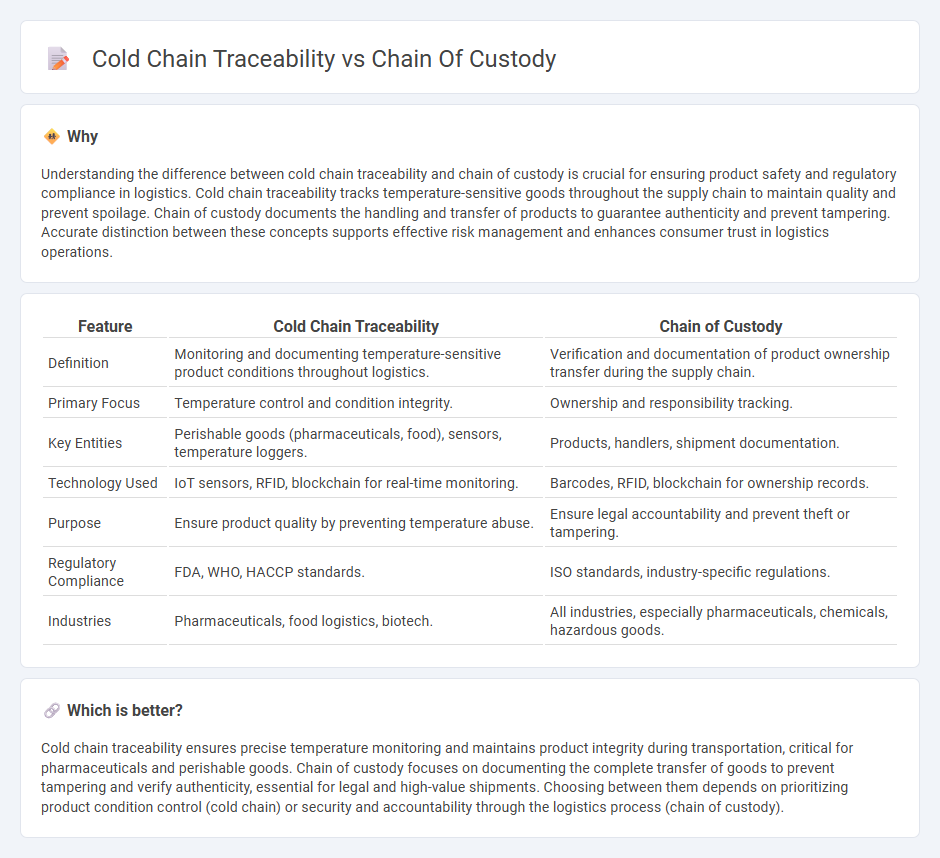
Cold chain traceability ensures temperature-sensitive products maintain required conditions from origin to destination, critical in pharmaceuticals and perishable goods. Chain of custody documents the entire transfer history of a product, verifying authenticity and integrity through each logistics step. Explore the differences and benefits of these systems to optimize supply chain transparency and compliance.
Why it is important
Understanding the difference between cold chain traceability and chain of custody is crucial for ensuring product safety and regulatory compliance in logistics. Cold chain traceability tracks temperature-sensitive goods throughout the supply chain to maintain quality and prevent spoilage. Chain of custody documents the handling and transfer of products to guarantee authenticity and prevent tampering. Accurate distinction between these concepts supports effective risk management and enhances consumer trust in logistics operations.
Comparison Table
| Feature | Cold Chain Traceability | Chain of Custody |
|---|---|---|
| Definition | Monitoring and documenting temperature-sensitive product conditions throughout logistics. | Verification and documentation of product ownership transfer during the supply chain. |
| Primary Focus | Temperature control and condition integrity. | Ownership and responsibility tracking. |
| Key Entities | Perishable goods (pharmaceuticals, food), sensors, temperature loggers. | Products, handlers, shipment documentation. |
| Technology Used | IoT sensors, RFID, blockchain for real-time monitoring. | Barcodes, RFID, blockchain for ownership records. |
| Purpose | Ensure product quality by preventing temperature abuse. | Ensure legal accountability and prevent theft or tampering. |
| Regulatory Compliance | FDA, WHO, HACCP standards. | ISO standards, industry-specific regulations. |
| Industries | Pharmaceuticals, food logistics, biotech. | All industries, especially pharmaceuticals, chemicals, hazardous goods. |
Which is better?
Cold chain traceability ensures precise temperature monitoring and maintains product integrity during transportation, critical for pharmaceuticals and perishable goods. Chain of custody focuses on documenting the complete transfer of goods to prevent tampering and verify authenticity, essential for legal and high-value shipments. Choosing between them depends on prioritizing product condition control (cold chain) or security and accountability through the logistics process (chain of custody).
Connection
Cold chain traceability ensures the continuous monitoring and documentation of temperature-sensitive goods throughout the logistics process, maintaining product integrity and compliance. Chain of custody provides a verified record of the handling and transfer of these goods at every stage, safeguarding against tampering and contamination. Together, they enhance supply chain transparency, regulatory compliance, and quality assurance in cold chain logistics.
Key Terms
Chain of custody:
Chain of custody ensures the documented and unbroken transfer of ownership or control of a product or evidence, maintaining its integrity and authenticity throughout the supply chain. It is critical in industries such as pharmaceuticals, food safety, and legal evidence handling to prevent tampering, contamination, or fraud. Explore detailed methodologies and technologies used to enhance chain of custody protocols for comprehensive traceability.
Documentation
Chain of custody documentation meticulously records the transfer and custody of goods or evidence, ensuring legal integrity and accountability throughout the supply chain. Cold chain traceability documentation tracks temperature-sensitive products from origin to destination, verifying compliance with specific temperature ranges to maintain product quality and safety. Explore detailed strategies to optimize documentation processes for both chain of custody and cold chain traceability.
Security
Chain of custody ensures secure tracking of goods through every transfer point, maintaining unbroken documentation to prevent tampering or fraud. Cold chain traceability adds temperature monitoring to preserve product integrity during transport, crucial for pharmaceuticals and perishable foods. Explore how these security measures safeguard supply chains in detail.
Source and External Links
What Is Chain of Custody? Definition and Examples - ThoughtCo - The chain of custody is a chronological paper trail documenting when, how, and by whom individual items of evidence are handled, ensuring their integrity from collection to court presentation to prevent tampering or contamination.
Chain of custody - Wikipedia - Chain of custody is the documented sequence of custody, control, transfer, and analysis of evidence to prove its authenticity and ensure it has not been accessed or altered improperly, crucial for legal admissibility.
Chain of Custody and Security - the Texas Secretary of State - Chain of custody establishes who has accessed and handled an important, tamper-free item, documenting possession and transfer to protect its integrity, often applied in contexts like elections involving ballots and equipment.
 dowidth.com
dowidth.com